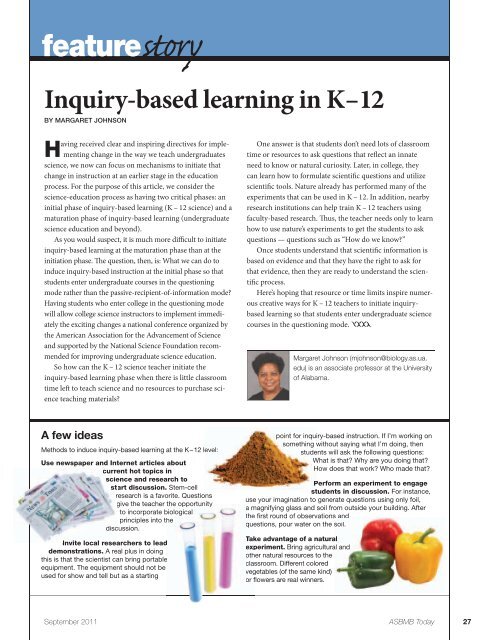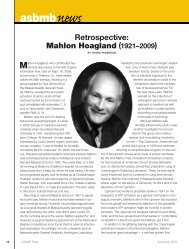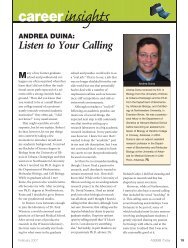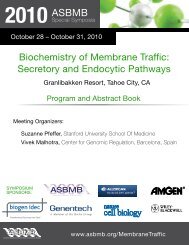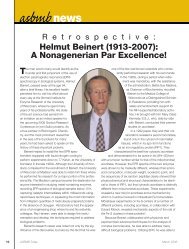asbmbnews
asbmbnews
asbmbnews
Create successful ePaper yourself
Turn your PDF publications into a flip-book with our unique Google optimized e-Paper software.
featurestory<br />
Inquiry-based learning in K – 12<br />
BY MARGARET JOHNSON<br />
H<br />
aving received clear and inspiring directives for implementing<br />
change in the way we teach undergraduates<br />
science, we now can focus on mechanisms to initiate that<br />
change in instruction at an earlier stage in the education<br />
process. For the purpose of this article, we consider the<br />
science-education process as having two critical phases: an<br />
initial phase of inquiry-based learning (K – 12 science) and a<br />
maturation phase of inquiry-based learning (undergraduate<br />
science education and beyond).<br />
As you would suspect, it is much more difficult to initiate<br />
inquiry-based learning at the maturation phase than at the<br />
initiation phase. The question, then, is: What we can do to<br />
induce inquiry-based instruction at the initial phase so that<br />
students enter undergraduate courses in the questioning<br />
mode rather than the passive-recipient-of-information mode?<br />
Having students who enter college in the questioning mode<br />
will allow college science instructors to implement immediately<br />
the exciting changes a national conference organized by<br />
the American Association for the Advancement of Science<br />
and supported by the National Science Foundation recommended<br />
for improving undergraduate science education.<br />
So how can the K – 12 science teacher initiate the<br />
inquiry-based learning phase when there is little classroom<br />
time left to teach science and no resources to purchase science<br />
teaching materials?<br />
A few ideas<br />
Methods to induce inquiry-based learning at the K – 12 level:<br />
Use newspaper and Internet articles about<br />
current hot topics in<br />
science and research to<br />
start discussion. Stem-cell<br />
research is a favorite. Questions<br />
give the teacher the opportunity<br />
to incorporate biological<br />
principles into the<br />
discussion.<br />
Invite local researchers to lead<br />
demonstrations. A real plus in doing<br />
this is that the scientist can bring portable<br />
equipment. The equipment should not be<br />
used for show and tell but as a starting<br />
One answer is that students don’t need lots of classroom<br />
time or resources to ask questions that reflect an innate<br />
need to know or natural curiosity. Later, in college, they<br />
can learn how to formulate scientific questions and utilize<br />
scientific tools. Nature already has performed many of the<br />
experiments that can be used in K – 12. In addition, nearby<br />
research institutions can help train K – 12 teachers using<br />
faculty-based research. Thus, the teacher needs only to learn<br />
how to use nature’s experiments to get the students to ask<br />
questions — questions such as “How do we know?”<br />
Once students understand that scientific information is<br />
based on evidence and that they have the right to ask for<br />
that evidence, then they are ready to understand the scientific<br />
process.<br />
Here’s hoping that resource or time limits inspire numerous<br />
creative ways for K – 12 teachers to initiate inquirybased<br />
learning so that students enter undergraduate science<br />
courses in the questioning mode.<br />
Margaret Johnson (mjohnson@biology.as.ua.<br />
edu) is an associate professor at the University<br />
of Alabama.<br />
point for inquiry-based instruction. If I’m working on<br />
something without saying what I’m doing, then<br />
students will will ask the following questions:<br />
What is that? that? Why are you doing that? that?<br />
How does that work? Who made that?<br />
Perform an experiment to engage<br />
students in discussion. For instance,<br />
use your imagination to generate questions using only foil,<br />
a magnifying glass and soil soil from outside outside your building. After<br />
the first round of observations and<br />
questions, pour water on the soil.<br />
Take advantage of a natural<br />
experiment.<br />
Bring agricultural and<br />
other natural resources to the<br />
classroom. Different colored<br />
vegetables (of the same kind)<br />
or flowers are real winners.<br />
September 2011 ASBMB Today 27


